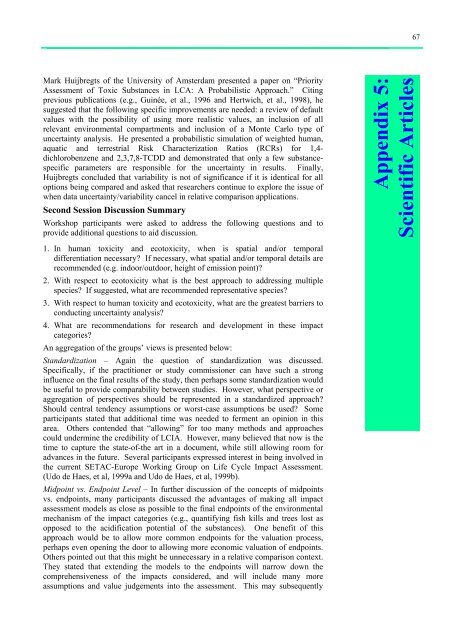Evaluation of Environmental Impacts in Life Cycle Assessment - estis
Evaluation of Environmental Impacts in Life Cycle Assessment - estis
Evaluation of Environmental Impacts in Life Cycle Assessment - estis
Create successful ePaper yourself
Turn your PDF publications into a flip-book with our unique Google optimized e-Paper software.
67<br />
Mark Huijbregts <strong>of</strong> the University <strong>of</strong> Amsterdam presented a paper on “Priority<br />
<strong>Assessment</strong> <strong>of</strong> Toxic Substances <strong>in</strong> LCA: A Probabilistic Approach.” Cit<strong>in</strong>g<br />
previous publications (e.g., Gu<strong>in</strong>ée, et al., 1996 and Hertwich, et al., 1998), he<br />
suggested that the follow<strong>in</strong>g specific improvements are needed: a review <strong>of</strong> default<br />
values with the possibility <strong>of</strong> us<strong>in</strong>g more realistic values, an <strong>in</strong>clusion <strong>of</strong> all<br />
relevant environmental compartments and <strong>in</strong>clusion <strong>of</strong> a Monte Carlo type <strong>of</strong><br />
uncerta<strong>in</strong>ty analysis. He presented a probabilistic simulation <strong>of</strong> weighted human,<br />
aquatic and terrestrial Risk Characterization Ratios (RCRs) for 1,4-<br />
dichlorobenzene and 2,3,7,8-TCDD and demonstrated that only a few substancespecific<br />
parameters are responsible for the uncerta<strong>in</strong>ty <strong>in</strong> results. F<strong>in</strong>ally,<br />
Huijbregts concluded that variability is not <strong>of</strong> significance if it is identical for all<br />
options be<strong>in</strong>g compared and asked that researchers cont<strong>in</strong>ue to explore the issue <strong>of</strong><br />
when data uncerta<strong>in</strong>ty/variability cancel <strong>in</strong> relative comparison applications.<br />
Second Session Discussion Summary<br />
Workshop participants were asked to address the follow<strong>in</strong>g questions and to<br />
provide additional questions to aid discussion.<br />
Appendix 5:<br />
Scientific Articles<br />
1. In human toxicity and ecotoxicity, when is spatial and/or temporal<br />
differentiation necessary? If necessary, what spatial and/or temporal details are<br />
recommended (e.g. <strong>in</strong>door/outdoor, height <strong>of</strong> emission po<strong>in</strong>t)?<br />
2. With respect to ecotoxicity what is the best approach to address<strong>in</strong>g multiple<br />
species? If suggested, what are recommended representative species?<br />
3. With respect to human toxicity and ecotoxicity, what are the greatest barriers to<br />
conduct<strong>in</strong>g uncerta<strong>in</strong>ty analysis?<br />
4. What are recommendations for research and development <strong>in</strong> these impact<br />
categories?<br />
An aggregation <strong>of</strong> the groups’ views is presented below:<br />
Standardization – Aga<strong>in</strong> the question <strong>of</strong> standardization was discussed.<br />
Specifically, if the practitioner or study commissioner can have such a strong<br />
<strong>in</strong>fluence on the f<strong>in</strong>al results <strong>of</strong> the study, then perhaps some standardization would<br />
be useful to provide comparability between studies. However, what perspective or<br />
aggregation <strong>of</strong> perspectives should be represented <strong>in</strong> a standardized approach?<br />
Should central tendency assumptions or worst-case assumptions be used? Some<br />
participants stated that additional time was needed to ferment an op<strong>in</strong>ion <strong>in</strong> this<br />
area. Others contended that “allow<strong>in</strong>g” for too many methods and approaches<br />
could underm<strong>in</strong>e the credibility <strong>of</strong> LCIA. However, many believed that now is the<br />
time to capture the state-<strong>of</strong>-the art <strong>in</strong> a document, while still allow<strong>in</strong>g room for<br />
advances <strong>in</strong> the future. Several participants expressed <strong>in</strong>terest <strong>in</strong> be<strong>in</strong>g <strong>in</strong>volved <strong>in</strong><br />
the current SETAC-Europe Work<strong>in</strong>g Group on <strong>Life</strong> <strong>Cycle</strong> Impact <strong>Assessment</strong>.<br />
(Udo de Haes, et al, 1999a and Udo de Haes, et al, 1999b).<br />
Midpo<strong>in</strong>t vs. Endpo<strong>in</strong>t Level – In further discussion <strong>of</strong> the concepts <strong>of</strong> midpo<strong>in</strong>ts<br />
vs. endpo<strong>in</strong>ts, many participants discussed the advantages <strong>of</strong> mak<strong>in</strong>g all impact<br />
assessment models as close as possible to the f<strong>in</strong>al endpo<strong>in</strong>ts <strong>of</strong> the environmental<br />
mechanism <strong>of</strong> the impact categories (e.g., quantify<strong>in</strong>g fish kills and trees lost as<br />
opposed to the acidification potential <strong>of</strong> the substances). One benefit <strong>of</strong> this<br />
approach would be to allow more common endpo<strong>in</strong>ts for the valuation process,<br />
perhaps even open<strong>in</strong>g the door to allow<strong>in</strong>g more economic valuation <strong>of</strong> endpo<strong>in</strong>ts.<br />
Others po<strong>in</strong>ted out that this might be unnecessary <strong>in</strong> a relative comparison context.<br />
They stated that extend<strong>in</strong>g the models to the endpo<strong>in</strong>ts will narrow down the<br />
comprehensiveness <strong>of</strong> the impacts considered, and will <strong>in</strong>clude many more<br />
assumptions and value judgements <strong>in</strong>to the assessment. This may subsequently
















